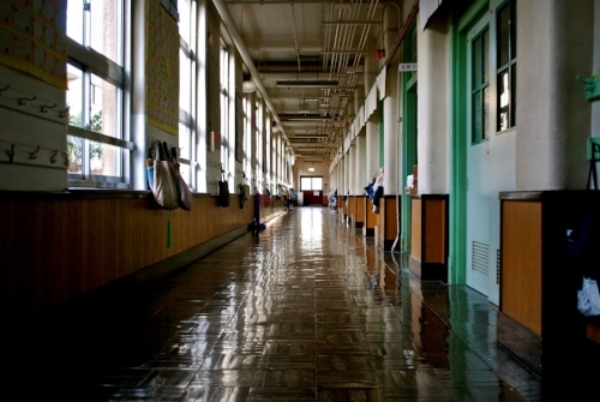Most teachers know that attrition has been a problem in the profession for years, but the issue of teacher turnover has recently piqued much broader public interest.
2018 has been described as “the school year teachers reached their breaking point,” leading to nationwide protests against low pay and poor working conditions. As one music educator in Indiana explained,
“When you cut off and starve public education, make it difficult for teachers to do their job and make it a demoralizing, de-professionalized career, you start to see teachers at state capitols.”
These conditions also cause many teachers to quit entirely, leading to high rates of turnover in schools. This “revolving door” of teachers is not just inconvenient for schools – teacher turnover harms student achievement, discourages educators, and is expensive for districts.
To maximize student performance and minimize teacher protests, we have to develop long-term solutions to help schools retain effective teachers.

The Crisis of Teacher Turnover
ECONOMIC CUTS
The heightened urgency of teacher turnover today can be traced back to The Great Recession. John Ahlquist, a professor who studies labor movements, explains,
“In 2010, in the middle of a massive economic recession, all state governments were deep in the red…Cuts were going to be made. The question was: Who was going to absorb the cuts?”
The answer—one of the answers—was teachers.
Pre-recession student-teacher ratios were 15.2-to-1 on average, whereas student-teacher ratios during the recession became 16-to-1, and state education budgets dropped sharply in 2008.
Even now that the recession has ended, most teachers have seen no increase in pay, student-teacher ratios have remained at recession levels, and many of the classes and programs that were cut have yet to be reinstated.
TEACHER STRESS
While the recession exacerbated many of the financial pressures on teachers, it didn’t create the problems in the first place.
If you have read our article on Teacher Stress, you already know some of the most important sources of teacher turnover. Less than a third of teachers who stop teaching are retiring, and “of those who leave teaching voluntarily, most teachers list some type of dissatisfaction as very important or extremely important in their decision to leave the profession.”
Lack of administrative support is one of the most frequently cited reasons why teachers quit, and one study found that teachers who perceived their administrators as unsupportive were more than twice as likely to leave compared to more well-supported teachers.
According to reports from the University Council for Educational Administration and the Learning Policy Institute, other factors that contribute to teacher dissatisfaction and turnover include:
- Testing and accountability pressures
- Lack of opportunity for advancement
- Non-competitive salaries
- Inadequate facilities
- Large class sizes
- Lack of input and control over teaching decisions
These unfavorable working conditions have contributed to high levels of teacher attrition—the current rate is estimated to be around 8% annually. This 8% represents hundreds of thousands of teachers lost every year, and the majority of them are not retiring but quitting the field for other professions.
It’s hard to know exactly how high 8% is without a comparison: in “high achieving jurisdictions” like Finland, Singapore, and Canada, only about 3% to 4% of teachers leave in any given year.

Teacher Turnover by Subpopulations
While stress and lack of autonomy drive high turnover rates throughout the U.S., attrition also varies across regions within the country.
According to a groundbreaking report by the Learning Policy Institute, teacher turnover tends to be higher in urban areas than suburban or rural districts. The South also experiences a higher average turnover rate (about 16%) than the rest of the country, and the Northeast experiences the lowest rate since these states “tend to offer higher pay, support smaller class sizes, and make greater investments in education.”
Teacher shortages, an important measure of teacher attrition, are also severe in:
- California
- Arizona
- Nevada
- Oklahoma
- Washington
Even within those states however, teacher turnover and shortages differ across subjects. There consistently tend to be more teacher shortages in:
- Mathematics
- Science
- Special education
- English language development.
To be more specific, “in the 2015–16 school year, 48 states and the District of Columbia reported shortages in special education; 42 states plus DC did so in mathematics; and 40 states and DC reported teacher shortages in science.”
STEM teacher turnover is especially problematic since there is never an “oversupply” of teachers in these subjects to cover attrition. However, perhaps the most striking variation in teacher attrition concerns race.
According to Stanford researchers, teachers are more likely to remain in schools that have higher concentrations of white students. Predictably, then, “teachers in high-poverty, high-minority schools tend to have higher rates of attrition, as do teachers of color, who are disproportionately represented in these schools.”
As of 2016, turnover is 50% higher in Title I schools and 70% higher for teachers who serve in schools with the most students of color, leading to even more change and chaos for the very students who could most benefit from stability.

The Consequences of Teacher Turnover
UNCERTIFIED TEACHERS
“If you were a sixth grader in Petersburg City Schools last year, at no point did you have a licensed math teacher provide instruction. Not a single day.”
— Virginia State Superintendent Steven Staples
Although many states are already experiencing critical shortages of teachers, the situation might only get worse.
The National Center for Education Statistics “predicts the school-going population will increase by roughly 3 million students in the next decade” after a decade of relatively level enrollment.
The inevitable result of shortages? Uncertified and under qualified teachers in the classroom.
Research shows again and again that teachers are the single most important factor in student achievement. In the “100,000 classrooms across the country staffed by an instructor who is not fully qualified to teach,” we are doing the students a disservice.
Examining statistics about unqualified teachers can also be misleading because sometimes districts will try to lower the qualifications for certification to address teacher turnover.
In Mississippi, where over a fourth of districts have a critical shortage of teachers, there was a recent proposal to lower standards and allow teaching candidates who only “earned a 2.75 GPA in the subject area they want to teach.”
Unfortunately, teacher shortages and uncertified teachers disproportionately impact America’s most underprivileged students, as superintendent Steven Staples points out.
As of the 2013-2014 school year, “high-minority schools had four times as many uncertified teachers as low-minority schools.” Uncertified teachers and teachers at high-minority schools are most likely to leave, which creates a bigger shortage of teachers at those schools, which pressures the schools into hiring more uncertified teachers—and the cycle continues.

HOW TEACHER TURNOVER CAN HARM STUDENT ACHIEVEMENT
It should come as no surprise that, most of all, high rates of teacher turnover harms student achievement.
One Vanderbilt study found that “losing a teacher during the school year is linked with a loss of between 32 and 72 instructional days,” which equates to one sixth to nearly half of the school year.
One unprecedented study collected data on 1.1 million New York elementary school students over a decade and found that students in “grade-levels with higher turnover score lower in both ELA and math” and eliminating teacher turnover entirely “increased student achievement in math by 2 percent to 4 percent of a standard deviation.”
As the University Council for Educational Administration emphasizes, mid-year turnover “disrupts the continuity of a child’s learning experience,” breaking the student-teacher and parent-teacher relationships that have formed and weakening the academic support system for students.
However, the negative effects of turnover aren’t limited to the students whose teachers leave. The most surprising part of the study on New York elementary schools was not the direct negative effect of teacher turnover on students in grade-levels with high turnover, but the indirect effect on students who weren’t in those grades.
As the authors explain, before their study was published, effectiveness was generally thought of as something that a specific teacher has (or doesn’t).
In that line of reasoning, substituting effective teachers with effective teachers (or ineffective teachers with ineffective teachers) should not have an effect on the school at large. However, the study found that “there is a disruptive effect of turnover beyond changing the composition in teacher quality,” thereby impacting the achievement of all students in high turnover schools.
The explanation for this widespread effect lies in the burden on the teachers who stay, often called “bystander teachers” or “stayers.”
In interviews done with Tennessee teachers in schools with high rates of turnover (often over 40% and even as high as 70%), stayers noticed many negative effects of turnover including:
- Repetitive professional development
- Disruption of program planning
- Reduced time spent with students as stayers supported new colleagues
- Loss of teacher experience
- Loss of innovation and ability to introduce new practices
- Burnout of stayers
All of these negative impacts on bystander teachers will ultimately impact their ability to teach well, which negatively impacts their students’ achievement.
This constant turmoil and change hurt schools’ progress on a structure level as well. As the authors of the New York study note, and as stayers well know, constant turnover means that “schools are always starting over” rather than moving forward.

THE COST OF TEACHER TURNOVER
One of the most quantifiable effects of high teacher turnover is the financial cost to school districts.
Some experts estimate that each teacher who leaves costs about $9,000 in rural districts and as much as $21,000 in urban districts.
In 2007, the National Commission on Teaching and America’s Future did a pilot study to examine the cost of teacher turnover in diverse districts across the U.S—small and large, urban and rural. According to their findings, the following numbers represent the average cost of one teacher leaving in each school district:
- Jemez Valley, New Mexico (small rural district): $4,366
- Granville County, North Carolina: $10,000
- Milwaukee: $15,325
- Chicago (very large urban district): $17,872 per teacher with a total cost of over $86 million per year
The Learning Policy Institute even has an engaging tool to help you estimate the cost of teacher turnover in your area. However, as the authors of the NCTAF study conclude, no matter where you are, “it is clear that thousands of dollars walk out the door each time a teacher leaves.”
Teacher Retention Strategies
Teacher turnover is a problem that requires thoughtful long-term solutions.
Short-term solutions, like Mississippi lawmakers’ proposal to lower the standards for teaching candidates, “may temporarily curb the fear of empty classrooms,” but in the long run they contribute to the very problems they attempt to solve.
However, some researchers also warn that we should be careful not to assume that all teacher attrition is bad. One study done on elementary school teachers in New York found that the students of teachers that left after their first year had lower achievement gains than the students of other teachers at their school.
This is not entirely surprising. In all fields, some people will make poor initial career choices and either realize the incompatibility early on or be made to realize it at some point by their bosses (in this case, through “’counseling out’ by school officials”).
Even if high rates of turnover negatively impact schools on average, the goal should not be to reduce turnover rates to zero, particularly turnover for first-year teachers.
Instead of combatting all teacher turnover, a report on teacher attrition suggests that teacher retention strategies should both “create incentives to retain teachers who are the most effective” and “support the improvement of less-effective teachers or encourage them to leave.” For more on how to make teachers more effective, read our article here.

TEACHER COMPENSATION
The solutions that incentivize effective teachers to stay generally fall into three categories:
- Better compensation
- Effective hiring and mentoring
- Increased principal support
Teacher pay has been discussed more frequently in the past few years because many of the teachers who protested at state capitols were in part protesting about compensation.
Recent articles have highlighted the large number of teachers picking up second and third jobs to pay the bills, and research has shown that “teachers in districts with stronger salary schedules are much less likely to leave their schools or the profession than teachers in districts with poorer pay scales.”
In fact, “districts where teachers could expect to one day earn around $78,000 had a turnover rate that was 31 percent lower than those districts where salaries maxed out at less than $60,000.”
The number one recommendation regarding teacher compensation is to raise teacher salaries to be competitive with other occupations (rather than 20-30% less than other jobs that require college degrees). In conjunction with doing so, the Learning Policy Institute has a number of recommendations for teacher pay:
- Make teaching more affordable by providing housing support and child care support
- Provide forgivable loans, service scholarships, and stipends that help attract teachers to high need schools
- Make salaries more equitable across districts so high need schools have a fairer shot at recruiting effective teachers
- Provide extra compensation to teachers in mentoring and leadership roles to retain expert and veteran teachers
HIRING AND MENTORSHIP
Another intuitive and research-backed way to reduce teacher turnover is to recruit effective teaching candidates that are a good fit with the school and then provide sufficient mentoring to help them make the transition into full-time teaching.
Analysis of high-performing urban schools reveals that these schools often have a prolonged hiring process that may include many or all of the following steps:
- Screening of resumes and cover letters
- Pre-interview screening
- An interview with the principal
- A teaching demonstration and debrief
- A school visit where the candidate meets other teachers
To ease the burden of the hiring process on principals alone, current staff can be used to recruit and vet candidates—with compensation for their time and bonuses upon successfully finding future hires. This process would also confirm that the teacher is a mutual fit with the existing staff and would already begin to integrate the teacher into social networks at their new school.
Since this method of hiring is more involved, it helps to push hiring processes earlier, ideally before the school year ends. Several policies and laws have been passed in California to encourage just that.
Statewide law “requires that seniority-based voluntary-transfer processes [are] completed by April 15, thereby freeing principals to consider all teacher candidates equally after this date,” and San Francisco Unified School District has an incentive program that gives a stipend to teachers who announce their retirement or intention to leave by March 1. Hiring teachers earlier goes a long way toward making the between-year turnover that does exist less tumultuous for the school as a whole.
After hiring new teachers, it is important not to throw them into their first year of teaching without sufficient mentoring and support.
As the Learning Policy Institute emphasizes, the first year of teaching is highly important for the teacher’s career trajectory; “depending on the amount and quality of support they encounter in their first teaching job, new teachers can grow into highly competent ones—or they may develop counterproductive approaches or leave the profession entirely.”
Induction programs for new teachers are correlated with twice as high teacher retention rates. Such programs can include:
- Orientations
- Retreats
- Feedback from veteran teachers
- Observations of veteran teachers
- Additional classroom assistance
- Lower workloads
Ongoing support for new teachers can include more collaborative teaching (see our post on Teacher Roles for more) and ongoing mentorship. It is encouraging indeed that most efforts to decrease teacher turnover will inevitably also increase teacher effectiveness for new and old teachers alike.

PRINCIPAL SUPPORT
In conjunction with better compensation, hiring processes, and induction programs, better principal-teacher relationships can be a powerful way to reduce teacher turnover.
As noted previously, many teachers name lack of principal support as the number one reason for leaving a particular school or the profession entirely.
Studies have found that the quality of administrative support is one of the best predictors of teacher attrition rates. In fact, more effective principals can even make teachers feel like they have more capacity in the classroom.
One study found that “increasing principal quality by one adjusted standard deviation” had the estimated effect of reducing class sizes to a student-teacher ratio of 8:1.
Teacher-principal relationships can be especially impactful in high-need schools.
“For the past decade, I’ve worked at a school where 97% of the children qualify for free and reduced-price lunch. I stay because the school climate is good for children and teachers alike. I stay because my principal is wonderful, supports us, does what’s best for children, and because I trust her.
— Kirsten Ragatz, veteran Minneapolis teacher
There are many steps that principals can take to build the kind of positive relationship that Kirsten Ragatz has with her principal.
One article on ways that principals and policymakers can address teacher turnover highlights these practices of effective principals:
- Creating strong school mission and vision
- Implementing routines and procedures to establish predictable and stable environment
- Supporting and encouraging teachers
- Communicating clear expectations
- Prioritizing trust and respect
- Buffering teachers from outside influences that interfere with teaching
- Involving teachers in decision making
- Providing consistent and useful feedback
Principals can also borrow strategies from other business leaders. For example, one guide suggests dedicating more resources to employee feedback since a 2014 Gallup survey showed that “companies that provide regular employee evaluations or feedback have a nearly 15 percent lower turnover rate than companies that don’t.”
Conducting exit interviews can also be a powerful way to “better understand and address causes of turnover.” Technology, such as software that allows teachers to regularly comment on progress toward school-wide goals, can also be harnessed toward that end.
In a similar vein, the guide suggests integrating more progressive technology that makes teachers’ lives easier and their practices more effective.
One prime way to do this is to partner with Marco Learning. Our trained grading assistants will help to reduce teachers’ grading time and get your students more detailed feedback on their writing assignments.
Since Marco Learning usually works with entire schools rather than individual teachers, by making that step, principals have the power to show teachers that their time and energy in the classroom is valuable and valued.
Once partnered with Marco Learning, teachers will have more time to mentor or be mentored, to engage in the hiring process, and to provide feedback for principals—all actions that will increase teacher satisfaction and reduce teacher turnover.

Looking Forward
If some of these strategies had been adopted by districts across the country in previous years, 2018 would likely have not been the year that teachers reached their breaking point and showed up with signs at state capitols.
That said, any breaking point can be a catalyst for change. Working conditions for teachers cannot be ignored any longer in states with critical shortages of certified teachers, and short-term solutions only guarantee another crisis a few years down the road.
It is by taking thoughtful action—increasing teacher pay, improving hiring and mentoring practices, and strengthening teacher-principal relations—that we ensure that teaching is a desirable occupation for aspiring teachers and a sustainable one for veteran teachers.
If we can help increase teacher satisfaction and reduce turnover at your school, you can reach out to us here.
 Help
Help